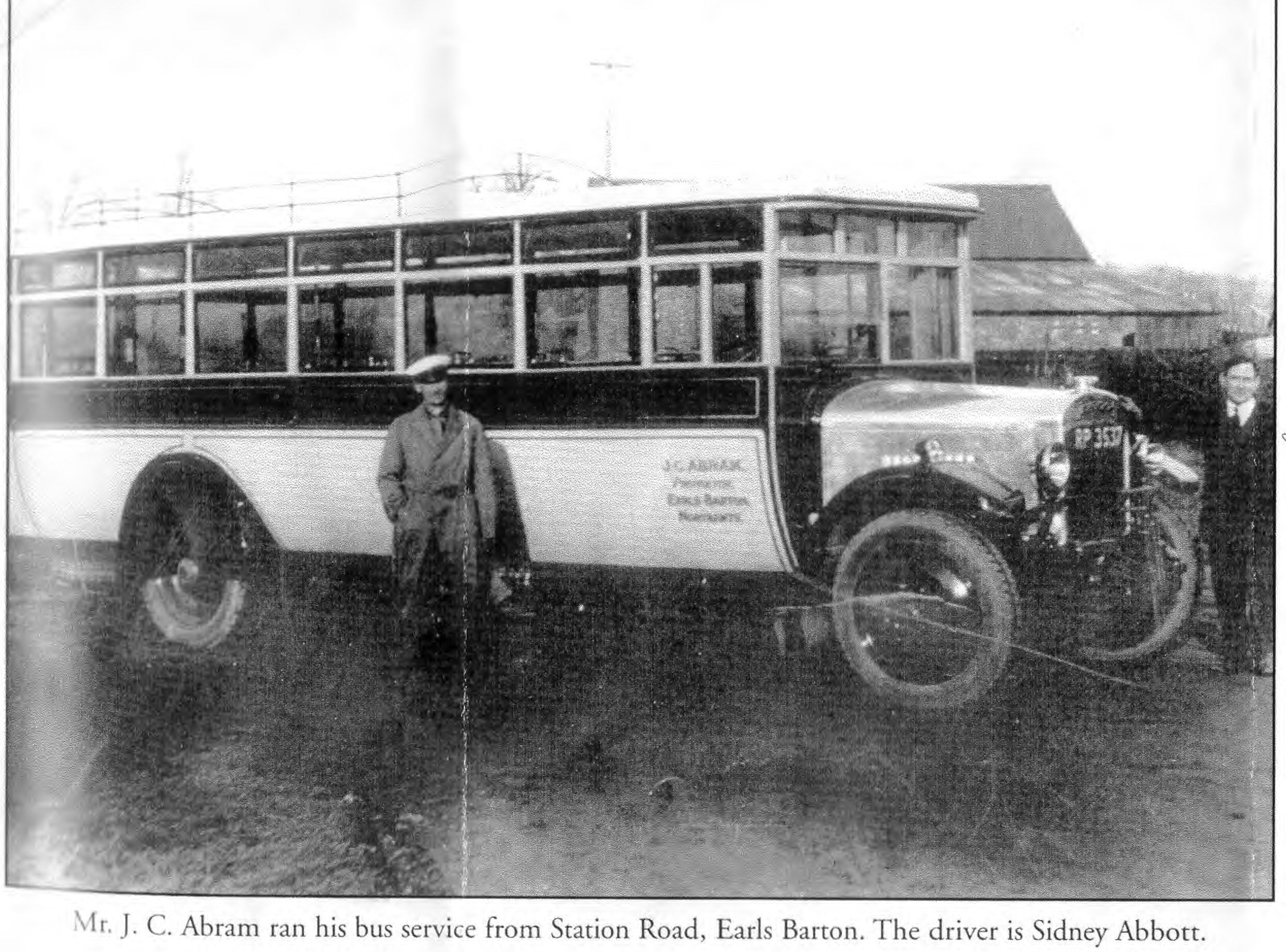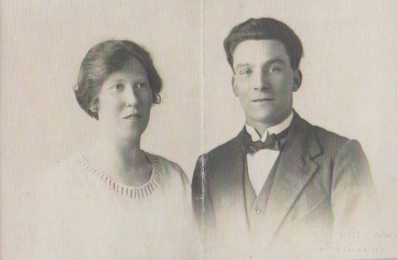Earls Barton is a village in Northamptonshire, situated in the borough of Wellingborough. The name comes from Bere-tun, which is Saxon for ‘a place for growing barley’. The prefix ‘Earls’ comes from a long association with the Earls of Northampton and Huntingdon. Earls Barton is known for its Anglo-Saxon and shoe making heritage — it is also the place where my ancestors lived and worked.
On leaving the army in 1922 my great grandfather Joseph Charles Abram returned to the village where his parents Charles and Emily lived. He built two houses on the Mears Ashby Road, choosing to live in one and sell the other. He was also the proprietor of Abram’s Buses and later Earls Barton Motors, known locally as Abram’s garage.
Abram’s Buses
The first motor bus had arrived in Earls Barton in 1921 and was owned by the village carrier who would have transported passengers and goods between towns and villages in the area. In 1924 Joseph purchased his first bus — a model T Ford saloon from Henry Oliver Ltd, a Northampton based Ford agent, for which he paid £221. The same year he was summoned for leaving a motor bus in Wellingborough without having taken due precautions to prevent it starting in his absence. Superintendent McLeod explained the vehicle had been left in Sheep Street where a constable had been able to jump on the vehicle and stop it before it had got too far. Joseph was fined £1

The main service Joseph provided operated between Earls Barton and Wellingborough but services also included a Saturday only service between the months of September to April for football supporters, services from Barker’s Shoe Factory in the village, an August Bank Holiday service to Castle Ashby, excursions to Yarmouth, Clacton and Skegness and a number of evening tour trips.
By August 1928 Joseph had a fleet of four buses. Newspaper articles from the time show that as the omnibus proprietor of a small bus company, Joseph took on the United Counties bus company on the road, in the press and in the courtroom —the much larger company had an operating area covering Northamptonshire, Bedfordshire, Buckinghamshire and Huntingdonshire, with services that reached into Lincolnshire, Leicestershire, Oxfordshire, Cambridgeshire, Rutland, London and Nottingham.
In a letter to the editor of the Northampton Mercury, Joseph wrote “I have been running my two buses (trying merely to get a living) for some few years now between Earls Barton and Wellingborough and was the first to commence early morning journeys for workmen between those places.” United Counties responded saying that “the authorities concerned should think seriously about granting a ‘small man’ a licence”.
It was also reported in the press that Joseph applied for a new co-ordination between his services and the United Counties Omnibus Bus Company Ltd between Earls Barton and Wellingborough, due to overcrowding on the route and United Counties not keeping to the scheduled times. As such “a start two minutes later could be of great importance.” Mr Troup applying on behalf of Joseph said “The last Earls Barton census had a population of 2,800, yet no fewer than 111 passenger buses ran into it every Saturday and 120 out.” He continued that “on Wednesday and Fridays 93 buses ran in and out, 68 on Monday, Tuesdays and Thursday and on Sundays 48 in and 49 out.” The Chairman (Mr J H Stirk) asked “does everybody move at Earls Barton every Saturday” and Mr Troup replied “I think they must.” William George Austin a United Counties inspector also advised that Mr Abram had complained on one occasion about a bus starting four minutes late but the driver said he started promptly having set his watch by the Regal Clock in Wellingborough which was met by laughter. It was concluded there were too many buses on the route but a decision would be deferred until loadings of the two services had been supplied.
Other newspaper reports exist of accidents, dangerous driving and a false statement made to the police by a driver for the United Counties Omnibus Company, who later admitted making the statement “because he was annoyed at the time by a woman who was one of Abrams’ customers insulting him.” When Joseph applied to run a service to Castle Ashby on the flower show day in the summer, it was report United Counties objected on the grounds there was an adequate service and that passengers had been left stranded which Joseph denied. The Chairman granted the application nonetheless saying “see you bring home all the people you take.” In the same article it was reported Joseph complained United Counties had a five minute service against him for a village of 3,000 people, so as to “squeeze the blood out of your body.”
In December 1930 Joseph offered his services and vehicles to United Counties but did not in fact sell his business to them until 1932. In March of that year Joseph advised them he was willing to dispose of his business which included four vehicles, two plots of land, a petrol pump and wooden garage — the business was sold on 23 March 1932.
On Friday 20 November 1931 the Northamptonshire Mercury reported that ‘an application had been made by J C Abram of Earls Barton to run his buses between Wellingborough and that place’ and further newspaper articles from the time show that as an Omnibus Proprietor of a small bus company he took on the United Counties bus company on the road, in the press and in the courtroom.
The document below, produced by The Omnibus Society, records Joseph’s life from September 1924 when Joseph purchased his first bus, to May 1932 when he sold his business to United Counties.
Joseph is also mentioned in the book United Counties Buses: A Fleet History, 1921 – 2014.
Earls Barton Motors (Abram’s Garage)
The sale of Abram’s Buses almost certainly assisted Joseph with his purchase of Abram’s Garage which Joseph advertised as ‘the reliable physicians for all motoring ailments.’ Complete overhauls and repairs were carried out to all makes of cars and commercial vehicles, with all repairs carried out by expert mechanics under personal supervision of the proprietor. Newspaper advertisements from the time also show that Joseph sold vehicles from the garage including a 1933 Austin light 124 saloon, 1934 Fordson end tipping lorry, 1932 Lanchester saloon and a 1930 Singer saloon.
In 1935 during his time as proprietor, Joseph was called as a witness at Wellingborough Police Court following an escapade by three youths who pleaded guilty to a number of offences including possessing a firearm. Joseph told how on 14 May dogs had awakened him — getting out of bed he heard clicking noises and saw a car driven away. The following morning he found two petrol pump globes had been broken apparently by bullets. Later the police found the pellets but Joseph could not say who was responsible. And the 1939 census of Earls Barton records Joseph as a Motor Engineer Garage Proprietor living at Abram’s Garage, Main Road with his wife Millicent (Milly May) and daughter Betty. Also residing with them is Albert E Evans, a haulage contractor and motor engineer.
World war two
During the war the garage was used for repairing aircraft parts for Sywell aerodrome. A document from the Harrington Museum states:
‘The number or aircraft needing repair increased rapidly during 1940 and the accommodation at the main centre at Sywell was found to be inadequate. This together with the policy of dispersal and the benefit of taking work to the people instead of the reverse with consequent saving in travelling, led to premises being requisitioned including Abram’s Garage, Earls Barton – used for
undercarriage and bomb beams.’
The full document can be viewed below.
The home guard
Ooold Soljer and Two Beauts
And on 31 March 1943 the garage was recorded as sustaining a broken window when, during a practice air raid, two B17 flying fortresses, Ooold Soljer and Two Beauts, collided, shedding bombs and spreading wreckage in Mears Ashby and Earls Barton — an information board now stands in Mears Ashby which advises visitors about the crash.
Aubrey Leighton
Joseph is believed to have run the garage successfully until sometime after the war and when he retired, he sold the garage to Aubrey Leighton, one of the pioneers of F1 stock car racing. Aubrey began racing in 1955 when the sport was about a year old. He went on to win 48 Finals, plus the National Points Championship in 1963. In only his third season of racing, Aubrey won the 1957 World Championship, staged at Belle Vue.




The Abram family however remained in Earls Barton. Joseph’s parents Charles and Emily who are first recorded as living there on the 1911 census can be found on the 1921 census and the 1939 census also. And on 24 March 1930 the Northampton Chronicle and Echo reported the old couple, who had lived in Earls Barton for twenty seven years, had fourteen children, six of who had served in the Great War with all of them returning home, had celebrated their 30th wedding anniversary.
Joseph died in 1970 at which time his residence was recorded as Mears Ashby Road, Earls Barton. There is no fancy obituary for Joseph, he was not a prince or a king, a politician or a film star, he was simply an ordinary man doing his best to make a living during an extraordinary time in history — yet reading his words and those of the people who knew him bring him to life and ensure he is not forgotten. How lucky am I to call this ‘regular joe’ my ancestor?
Sources
Earls Baron Parish Council
Abram’s Buses
- Bygone Buses article about Joseph Charles Abram
- United Counties Buses A Fleet History 1921 – 2014: David Beddall
Abram’s Garage
- Ebay: Earls Barton Northamptonshire First motor bus in 1921
- Harrington Museum: Premises used for military purposes
- Sywell Aviation Museum
- Waymarking: Mission 48 – Mears Ashby, Northamptonshire, UK
- War Memorials Online
Newspaper articles
- Northampton Chronicle and Echo
Summoned
28 November 1924
- Northampton Mercury
Charge against a bus driver dismissed
2 July 1926
- Northampton Mercury
Buses and competition:
A letter to the editor of the Mercury from J C Abram, Omnibus proprietor
5 November 1926
- Northampton Chronicle and Echo
Saloon buses for hire (party arrangements)
27 May 1927
- Northampton Mercury
An error of judgement costs a bus driver £2 at Wellingborough
21 October 1927 - Northampton Mercury
Bus overturns on joy trip to Hunstanton
9 August 1929
- Northampton Chronicle and Echo
A family of fourteen
24 March 1930 - Northampton Mercury
An application to run buses from Wellingborough to Earls Barton
20 November 1931
- Northampton Mercury
Application for a new co-ordination
26 February 1932
- Northampton Mercury
Petrol Pumps damaged
31 May 1935 - Northamptonshire Evening Telegraph
Vehicles for sale
17 June 1939 - Northamptonshire Evening Telegraph
Semi detached house for sale
15 September 1939


 Wellington Bombers flying in formation.
Wellington Bombers flying in formation.







